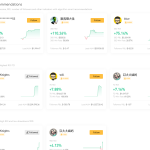With generative artificial intelligence (Al) becoming the talk of the town, many content-creating professionals such as writers, web editors, and painters have begun to give it a shot, sizing up the strength and prospects of the new technique.
A painting art blogger surnamed Kang is one of those who have thrown themselves into this new domain.
Type a combination of words into the prompt field at an AI painting platform developed by Westlake Xinchen technology company, choose an art style, and click the “create” button. In as fast as 0.8 seconds, the picture generated popped up on Kang’s computer screen.
“It’s an assistant for me that provides some useful insights and a tool that augments our capabilities,” Kang gave user feedback as such to the developer.
More creators have joined to ride the new wave of technology and utilized the tools to get their writing or drawing juices flowing. But from the fear of it being able to write university essays to make anyone from journalists to artists obsolete, these mysterious AI chatbots have sprung into public consciousness and triggered mixed responses.
NEW FRONTIERS
Chinese technology companies have begun making their dent in the generative AI space. Some have unveiled large language models, while others are developing industry-specific models covering various fields.
Speaking to Xinhua, founder of Westlake Xinchen company, Lan Zhengzhong, said China has been doing some terrific work in basic research, algorithms, and industrial application of AI models, and AI technology is a crucial tool for upgrading industries and boosting productivity.
Generative AI is able to support multi-dimensional interaction, integration, and penetration of digital content with other industries to provide new driving forces for various sectors, according to a white book released by the China Academy of Information and Communications Technology.
The use cases of generative AI are already taking flight across industries. Some financial services institutions are testing the technology to help financial advisers better leverage insights from the research reports, while the salesforce has integrated the technology into its customer-relationship-management platform.
Tian Qi, chief scientist of Huawei Cloud AI field, said that AI technology has ushered in an explosion after decades of development. “It has not only changed the way humans interact with machines but also greatly enhanced productivity.”
The value of the generative AI market is set to reach 1.3 trillion U.S. dollars by 2032 from just 40 billion dollars in 2022, according to a report by Bloomberg Intelligence.
The compound annual growth rate for the sector over the next ten years could expand by 42 percent, driven first by training infrastructure and then inference devices for large language models, advertising, and other services, the report added.
INDUSTRIAL CONCERNS
But the commercial use of generative AI chatbots has triggered concerns, including upending the professional sector, ethics, and leaks that infringe on personal privacy and data security.
“On one hand, generative AI will facilitate the automation and intelligent upgrading of certain job positions, potentially rendering them obsolete, but on the other hand, generative AI will also create new professions,” said Lan.
As for the protection of intellectual property rights, Du Lan, senior vice president of Chinese AI and intelligent speech company iFLYTEKAI, said that a balance should be struck between protecting the rights and interests of originators and encouraging innovation.
The Chinese internet regulator published a draft regulation on generative AI in April, covering a wide range of issues that are frequently debated in relation to the governance of generative AI globally, such as data protection, non-discrimination, bias, and the quality of training data.
Shayne Heffernan









